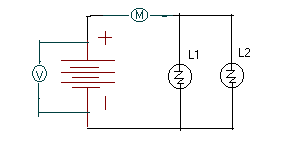BEE
PARALLEL CIRCUITS
Parallel Lights
* CAUTION: Working on energized circuits is dangerous and may result in ELECTROCUTION **
E = IR I = E/R R = E/I
Starting with a simple 2 branch ckt. it is obvious that the voltage from the battery is applied across both
branches of the circuit. The total current flow is equal to the current flow in each leg of the circuit. Unlike
a series circuit, were the current is the same everywhere in the circuit, the current may be different in each
leg of the parallel circuit. This is still easily calculated with ohms law. We simple calculate the "I" in each leg.
Measuring the battery voltage we find 30volts. Measuring the resistance of L1 and L2 we find that each
is 60ohms.
I = E/R
I = 30volts/60ohms
I = .5 amps.
Since we know both legs of the are the same all we have to do is multiply.
.5 amps. * 2 = 1 amp.
Another way of finding the current when both legs contain the same resistance is to simply divide the value
by 2.
60/2 = 30ohms
The value of 30ohms is known as the effective value of resistance in the circuit.
I = E/R
I = 30volts/30ohms
I = 1 amp.
This will work with any number of branches as long as they all have the same resistance.
If you have 10 branches each with 100ohms then 100/10 = 10ohms total effective resistance
If the values of resistance are not the same the effective value can be determined by the equation:
Rt = R1*R2 / R1+R2
This is called the product over the sum method.
The effective value will always be less then the value of the branch having the lowest resistance.
*********************************************************************************
PARALLEL CIRCUITS (more than two branches)
Parallel Lights
Rt=1/ ( 1/R1+ 1/R2+ 1/R3+...............1/Rn)
Test,Test,Test
Since we know from what we have read above that if we have resistors of equal values in a
parallel circuit to find the effective resistance we can divide that value by the number of
resistors. We will use this knowledge to prove the validity of the equation above. If we
have 4 legs of 10 ohms each the effective resistance is 1/4 of 10 or 2.5 ohms.
Rt=1/ ( 1/R1+ 1/R2+ 1/R3+ 1/R4
Rt = 1/ (1/10+ 1/10+1/10+1/10)
Rt = 1/ (0.1+0.1+0.1+0.1)
Rt = 1/ 0.4
Rt = 2.5
The effective value of any number of unlike resistors in parallel is equal to the reciprocal of
the sum of the reciprocals of the various resistors.
The resistance in a parallel circuit is always less then the value of the lowest resistance in
the circuit.
Hope this is of some help, GOD BLESS, Terry


